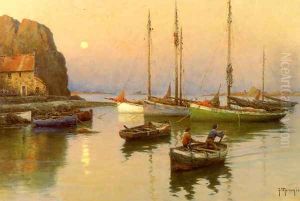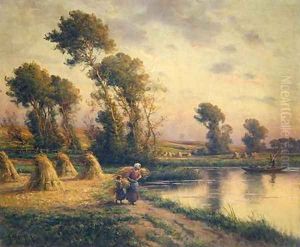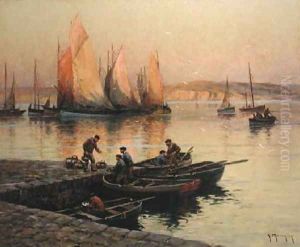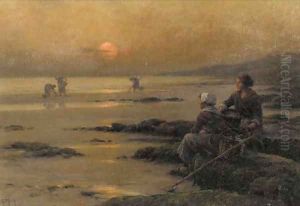Georges-Philibert-Charles Maroniez Paintings
Georges-Philibert-Charles Maroniez was a distinguished French painter and engraver, born in Douai, France, in 1865. His artistic journey began in the nurturing environment of the École des Beaux-Arts in Paris, where he was a student of notable figures such as Alexandre Cabanel and Fernand Cormon. Maroniez specialized in genre paintings, seascapes, and landscapes, capturing the essence of French rural and maritime life with a particular focus on the northern regions of France, including Brittany and Normandy, as well as scenes from his travels abroad.
Maroniez's work is characterized by its vibrant realism, a testament to his keen observation skills and his ability to capture the mood and atmosphere of his subjects. He was particularly adept at depicting the interplay of light and water, making his seascapes and maritime scenes especially compelling. His palette was versatile, ranging from the soft, muted tones of dawn and dusk to the bright, vivid colors of sunny coastal days.
Throughout his career, Maroniez exhibited his work widely, gaining recognition and accolades. He was a regular participant in the Paris Salon, an annual art exhibition established by the French Academy of Fine Arts, where he received several honors for his contributions to French art. His paintings were also exhibited internationally, helping to establish his reputation beyond France.
Beyond his artistic achievements, Georges-Philibert-Charles Maroniez was actively involved in the artistic community. He was a member of the Société des Artistes Français, a prestigious association of French artists, and contributed to its exhibitions and activities. His influence extended to the next generation of artists, as he shared his knowledge and passion for art through teaching and mentorship.
Maroniez's legacy is preserved in the collections of various museums and galleries across France and internationally, where his works continue to be admired for their beauty and historical value. He passed away in 1933, leaving behind a body of work that remains a significant part of French artistic heritage, celebrated for its portrayal of the natural beauty and cultural richness of his homeland.





